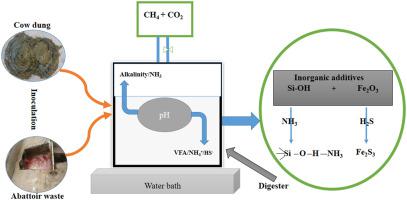Materials Today Chemistry ( IF 6.7 ) Pub Date : 2021-01-23 , DOI: 10.1016/j.mtchem.2020.100415 E. Mutegoa , N.M. Malima , A. Hilonga , K.N. Njau

|
In this study, the efficacy of inorganic additives in the removal of total ammonia nitrogen (TAN) and sulfide in the aqueous phase of slaughterhouse waste undergoing anaerobic digestion in the batch reactor was investigated. A mixture of natural inorganic additives processed from the anthill and red rock soil samples collected from Arusha, Tanzania were used as adsorbents in different ratios. These materials were chosen in regard to their abundance in the local environment, surface properties, and elemental composition. Before analysis, the materials were pulverized and calcined at 700 and 900 °C for 2 h in a furnace and then sieved to 250 μm fine particle size. XRD analysis revealed that the anthill soil sample is endowed with major mineral phases of quartz and hematite while red rock soil contains albite, pyroxene, and quartz as predominant phases. The anthill and red rock soil samples calcined at 900 °C displayed higher BET surface areas of 815.35 and 852.35 m2/g, respectively. The mixture of anthill soil and red rock soil in a ratio of 3:1 had a higher TAN removal efficiency of 92% at a contact time of 30 min compared to other ratios. On the other hand, a ratio of 1:2 showed a higher sulfide removal efficiency of 79% at a contact time of 60 min. Adsorption isotherm studies revealed that the Jovanovich model fitted better to the experimental data than the Langmuir and Freundlich models. The results demonstrated further that inorganic additives have a synergistic effect on stimulating methanogenesis as well as eliminating ammonia and sulfide during anaerobic digestion of slaughterhouse waste. Our findings demonstrate that anthill and red rock soils can be exploited as affordable, ecofriendly, and efficient adsorbents for mitigation of TAN and sulfide from the liquid phase and sustenance of methanogenesis.
中文翻译:

屠宰场废水厌氧消化过程中天然无机添加剂混合比对去除液相中氨和硫化物的影响
在这项研究中,研究了无机添加剂在间歇反应器中经过厌氧消化的屠宰场废水水相中去除总氨氮(TAN)和硫化物的功效。从坦桑尼亚阿鲁沙采集的蚁丘和红岩土壤样品中加工得到的天然无机添加剂混合物以不同比例用作吸附剂。选择这些材料时要考虑它们在局部环境中的丰度,表面性质和元素组成。在分析之前,将物料粉碎并在700和900°C的炉中煅烧2 h,然后筛分至250μm细粒度。XRD分析表明,蚁丘土壤样品具有石英和赤铁矿的主要矿物相,而红色岩石土壤则包含钠长石,辉石,和石英为主要相。在900°C下煅烧的蚁丘和红岩土壤样品显示出更高的BET表面积815.35和852.35 m2/ g。与其他比例相比,在30分钟的接触时间,比例为3:1的蚁丘土壤和红色岩石土壤的混合物具有更高的TAN去除效率,为92%。另一方面,在60分钟的接触时间,1:2的比例显示出79%的较高硫化物去除效率。吸附等温线研究表明,Jovanovich模型比Langmuir和Freundlich模型更适合实验数据。结果进一步表明,无机添加剂在厌氧消化屠宰场废物过程中具有促进甲烷生成以及消除氨和硫化物的协同作用。我们的研究结果表明,蚁丘和红色岩石土壤可被用作负担得起,生态友好和有效的吸附剂,以减轻液相中的TAN和硫化物和甲烷化的维持。










































 京公网安备 11010802027423号
京公网安备 11010802027423号